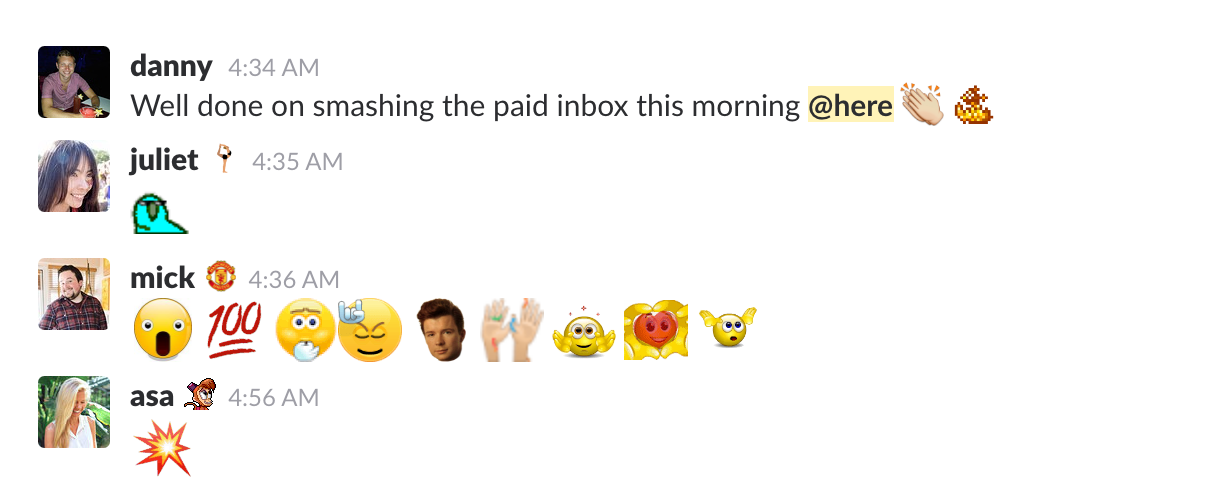
The 10 Slack Agreements of Buffer
Head of Communications & Content @ Buffer
Being spread across 50 different cities, we place a high priority on communication, going so far as to adopt it into our ten values.
For us, communication tends to break into two types, asynchronous or synchronous.
At most companies, synchronous communication is the norm. Everyone is online at the same time, chatting with the same tool, attending the same meetings and calls, etc.
Asynchronous communication becomes more critical for distributed teams. Asynchronous means not everyone needs to be online at the same time to have work continue or to have a meeting. We use tools like the forum software Discourse to have discussions as a team over several hours, kicking off the discussion when one teammate is online and letting it be picked up whenever another teammate might be online next.
Another tool that’s quite important for us is Slack. It allows our team to chat throughout the day using various channels to organize conversations. Slack is where we kick off calls with teammates, where we have conversations as a company and within teams, where we experiment with team building, and lots more.
In theory, Slack could also be used asynchronously, and we do try to use it that way as well by leaving messages for whenever people might be online. But recently, our Slack habits have slipped into being far more synchronous.
Instantly chatting and seeing conversations happening live makes it difficult to leave Slack, especially as a remote team looking to connect with each other. Constant notifications and conversations understandably lead to feelings of overwhelm on the team.
What would you call an all-day meeting with unknown participants and no agenda?
— Jason Fried (@jasonfried) February 18, 2016
So we put together the 10 Slack Agreements of Buffer and some best practices: our attempt at establishing common usage behavior that will help us get the most out of Slack while keeping our personal time our own. These are pulled right from our team communication guide. Feel free to adopt and use for your own team if you might find them helpful!

What is Slack used for?
We DO want to use Slack to communicate effectively and have fun as a team.
We DON’T want teammates to constantly monitor Slack after work hours or get pinged at any hour of the day or night.
Slack is the right place for:
- Social conversations, interesting links, chit-chat
- Questions/requests that need a faster/same-day response
- Realtime conversations with those in your timezone and async conversations with those outside your timezone
- Sharing some quick praise, Buffer love, gratitude, achievements
- Passing along non-urgent need-to-knows (often prefaced by NRN, or “No reply necessary”)
Slack is not the best place for:
- High-level discussions
- Making big decisions
- Giving in-depth feedback
Consider another communication tool like Discourse if you need to gather advice for a big decision or want to talk through a high-level issue. Consider email for providing feedback or advice to a teammate.
The 10 Slack Agreements of Buffer
1.You’re responsible for managing your downtime
It’s important that people can talk to each other even when the recipient is not around. If we’re each responsible for our own down time (i.e. setting yourself up on Do Not Disturb when you’re offline, not working, or in-the-zone; controlling notifications on your phone if you choose to install Slack there), we give the rest of the team full freedom to communicate as they like. It’s your responsibility then to deal with the message when you’re ready.
Tip: mark unread, star or click “remind me” for any items you need to take action on so you don’t forget!
2. Default to public channels
When in doubt, always post a message where everyone can read it. Keep everyone updated on stuff that is not private!

3. Use status and profile to communicate availability
Share your status to let folks know when you’re out sick, on vacation or just deep in a focus period. Additionally, Buffer’s Slack profiles include lots of great information like timezone, typical sign-on and -off times, and Calendly links. Make sure yours is filled out to help folks understand how best to communicate with you, and check others’ as you work with them.

4. Be deliberate about your notifications
We recommend keeping Slack’s recommended notification settings: only direct messages, @you and highlight words. These settings eliminate worry about missing important messages, without your phone or computer going off all day with less important conversations.

5. Communicate proactively
When you ping someone, go ahead and give that person all the context they’ll need in order to get back to you when they can. (e.g., no need to message “Hi Joel!” and then wait for a reply before saying more). Do include links, docs, your deadline or desired response time, anything that can move the conversation forward asynchronously.
6. Thread when you can
When you’re having a discussion with many people at once, things can get a little confusing, and ideas and opinions can get lost in the shuffle. Using threads when you can helps us all keep up with the conversations we need to follow.

7. Kill/modify Slack when you need to focus
Which doesn’t necessarily mean quitting it. You can set yourself away, or activate Do Not Disturb, or set your status to a focus mode when you want to focus on something without being interrupted.

8. Don’t keep checking messages in chat system constantly
Having unread messages on Slack doesn’t mean you have to read them immediately! Let people get on with their work, while you get on with yours. Save message-checking for when you are out of your focus zone.
9. @channel or @here?
Including @channel in a message will notify everyone that’s in the chat room, but using @here will only notify the people who happen to be online at that moment.
For non-urgent announcements, @here is always best.
Use @channel and @everyone for emergencies only – it sends push and email notifications to everyone, including people who may be offline or on vacation.

10. Reply by the end of your day
How fast should you expect a reply to a question or request you made of a teammate on Slack? You can expect a reply by the end of their normal workday, assuming:
- You’ve reached out to the teammate specifically by @-ing them (or sending them a DM if the content is sensitive)
- You didn’t share a specific deadline (always do this when you can!)
- They’re working a regular day (their Slack status and the #people-availability channel are good ways to determine this)
Urgent Situations and Emergencies
For urgent announcements, an @channel message sends push and email notifications to everyone in a given channel and @everyone notifies everyone on the team—including people who may be off work for the day or on vacation, so make sure it’s a real emergency!
If you need to reach a specific teammate for an urgent question or request, please make sure the word URGENT is in the message.
If you need to reach a specific teammate after hours or while they’re in Do Not Disturb mode, you can send a direct message and click on the “send notification” option Slackbot provides. This will send a push notification to that teammate even in DND.
Over to You
We’d love to hear about how your team communicates, how you use Slack and anything else that comes to mind!
- Do you use a tool to group chat at work? How does it affect your productivity?
- Does your team set up communication guidelines? What do they look like?
- What would you add or take away from our Slack agreements, how can we improve them?
These guidelines were put together by our wonderful People Team! Big thanks to Courtney Seiter, Jenny Terry, and Deborah Rippol.
Try Buffer for free
140,000+ small businesses like yours use Buffer to build their brand on social media every month
Get started nowRelated Articles

How the Buffer Customer Advocacy Team set up their book club, plus their key takeaways from their first read: Unreasonable Hospitality by Will Guidara.

In this article, the Buffer Content team shares exactly how and where we use AI in our work.

Here we go again. If you work in social media, it’s nothing new to adapt and change your strategy based on the ever-changing algorithms and the rise and fall of social networks. (Who else was on Vine? 🙋🏻♀️) But, of course, we wish you didn’t have to. The latest wave for social media marketers and creators is that TikTok might be banned in the U.S. The short-form video app has become one of the most widely-used social media platforms and is credited with impacting trends and cultural shifts.